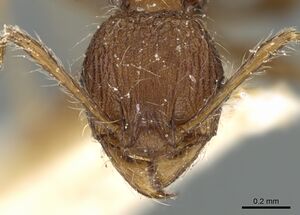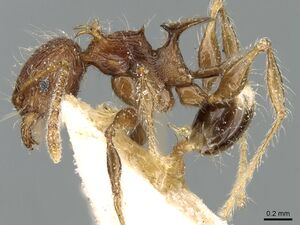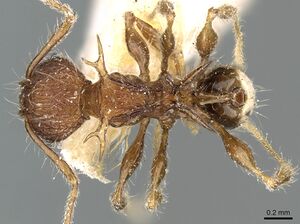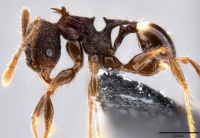Pheidole cervicornis
| Pheidole cervicornis | |
|---|---|

| |
| Scientific classification | |
| Kingdom: | Animalia |
| Phylum: | Arthropoda |
| Class: | Insecta |
| Order: | Hymenoptera |
| Family: | Formicidae |
| Subfamily: | Myrmicinae |
| Tribe: | Attini |
| Genus: | Pheidole |
| Species: | P. cervicornis |
| Binomial name | |
| Pheidole cervicornis Emery, 1900 | |
Aside from one nest collected from beneath a stone by Wilson, Pheidole cervicornis has only been recorded from stray foragers collected from the ground, in leaf litter, on logs, and in logs. It is the most widely collected species of the group, occurring along the northern coast of New Guinea, and also occupies the lowest elevation range (30–800 m). The species also appears to be more tolerant of disturbance than its close relatives, and has been collected in secondary and disturbed forest habitats. (Sarnat et al. 2016)
Identification
Sarnat et al. (2016) - Pheidole cervicornis, known only from the minor worker subcaste, is the most distinct member of its eponymous group. The minor workers are the only members of the group which have bifurcated pronotal spines. They are also immediately recognizable by the thickly crenulated rugulae on the head and mesosoma. Additionally, the minor worker has a more circular head with a broad, weakly emarginated posterior margin (vs. elongate head with a narrow and flat posterior margin), and all the limbs are relatively shorter. There is some variation in color between specimens collected from western New Guinea (darker and have a contrasting white spot on their gaster), and eastern New Guinea (lighter and lacking white spot).We consider this infraspecific variation until additional collections prove otherwise.
Keys including this Species
Distribution
Latitudinal Distribution Pattern
Latitudinal Range: -2.08° to -5.26°.
| North Temperate |
North Subtropical |
Tropical | South Subtropical |
South Temperate |
- Source: AntMaps
Distribution based on Regional Taxon Lists
Indo-Australian Region: New Guinea (type locality).
Distribution based on AntMaps
Distribution based on AntWeb specimens
Check data from AntWeb
Countries Occupied
| Number of countries occupied by this species based on AntWiki Regional Taxon Lists. In general, fewer countries occupied indicates a narrower range, while more countries indicates a more widespread species. |

|
Estimated Abundance
| Relative abundance based on number of AntMaps records per species (this species within the purple bar). Fewer records (to the left) indicates a less abundant/encountered species while more records (to the right) indicates more abundant/encountered species. |

|
Biology
Castes
Images from AntWeb
   
| |
| Syntype of Pheidole cervicornis. Worker. Specimen code casent0906634. Photographer Estella Ortega, uploaded by California Academy of Sciences. | Owned by HNHM, Budapest, Hungary. |
 X-ray micro-CT scan 3D model of Pheidole cervicornis (minor worker) prepared by the Economo lab at OIST.
X-ray micro-CT scan 3D model of Pheidole cervicornis (minor worker) prepared by the Economo lab at OIST.
See on Sketchfab. See list of 3D images.
Nomenclature
The following information is derived from Barry Bolton's Online Catalogue of the Ants of the World.
- cervicornis. Pheidole cervicornis Emery, 1900c: 322, pl. 8, fig. 25 (w.) NEW GUINEA. Combination in P. (Pheidolacanthinus): Emery, 1921f: 82; Donisthorpe, 1947b: 174.
Unless otherwise noted the text for the remainder of this section is reported from the publication that includes the original description.
Description
Worker
Sarnat et al. (2016) - Major Unknown.
Minor HW 0.58–0.64, HL 0.58–0.67, SL 0.61–0.67, FL 0.67–0.78, EL 0.10–0.11, ML 0.76–0.87, PSL2 0.29–0.37, PSL3 0.38–0.47, PeL 0.11–0.35, PeW 0.07–0.09, PpW 0.14–0.17, CI 94–101, SI 101–112. Most dark reddish brown with basal third of first gastral tergite a strongly contrasting white; at least one population from eastern New Guinea a uniform light reddish brown to dark reddish brown and lacking contrasting white portion of gaster. Head ovoid, approximately as wide as long. Posterior head margin relatively broad and flat to weakly concave. Nuchal carinae not visible in full face view. Antennal scapes with erect hairs, distinctly surpassing posterior head margin. Frontal carinae distinct and extending past eye level. Mesosoma with extremely long spines on the pronotum and propodeum, and shorter spines on the mesonotum. Pronotal armament begins as thick basal trunk that diverges into two long anterolaterally pointed prongs. Mesonotal spines approximately eye-length; directed posterolaterally and upturned. Propodeal spines fused basally into thick upright trunk before diverging; strongly bifurcate. Dorsal surface of propodeal spines modified into elongate, sharply margined concavities. Petiole very elongate. Petiolar node acuminate. Dorsal head surface opaque and strongly sculptured. Crenulated longitudinal rugulae become reticulated towards posterior head margin; interspaces strongly punctured. Mandibles weakly striate. Clypeus sculptured. Promesonotal dorsum with crenulated rugae traversing anterior portion and thick longitudinal rugae covering remaining portion. Waist and gaster entirely smooth and shining.
Relatively short-limbed species.
Type Material
Sarnat et al. (2016) - New Guinea, Lemien [= Aitape, Papua New Guinea] (L. Biró) Hungarian Natural History Museum, 1 syntype worker examined.
References
- Donisthorpe, H. 1947b. Pheidole (Pheidolacanthinus) striatus sp. n. from New Guinea, with notes on the subgenus Pheidolacanthinus F. Smith (Hym., Formicidae). Entomol. Mon. Mag. 83: 172-174 (page 174, Combination in P. (Pheidolacanthinus))
- Emery, C. 1900b. Formicidarum species novae vel minus cognitae in collectione Musaei Nationalis Hungarici quas in Nova-Guinea, colonia germanica, collegit L. Biró. Publicatio secunda. Természetr. Füz. 23: 310-338 (page 322, pl. 8, fig. 25 worker described)
- Emery, C. 1921c. Hymenoptera. Fam. Formicidae. Subfam. Myrmicinae. [part]. Genera Insectorum 174A:1-94 94: 1-94 + 7 (page 82, Combination in P. (Pheidolacanthinus))
- Fischer, G., Friedman, N.R., Huang, J.-P., Narula, N., Knowles, L.L., Fisher, B.L., Mikheyev, A.S., Economo, E.P. 2020. Socially parasitic ants evolve a mosaic of host-matching and parasitic morphological traits. Current Biology 30, 3639–3646.e4 (doi:10.1016/j.cub.2020.06.078).
- Sarnat E. M., Fischer, G. and E.P. Economo. 2016. Inordinate spinescence: taxonomic revision and microtomography of the Pheidole cervicornis species group (Hymenoptera, Formicidae). PLoS ONE. 11:e0156709. doi:10.1371/journal.pone.0156709
References based on Global Ant Biodiversity Informatics
- Donisthorpe H. 1947. Pheidole (Pheidolacanthinus) striatus sp. n. from New Guinea, with notes on the subgenus Pheidolacanthinus F. Smith (Hym., Formicidae). Entomologist's Monthly Magazine 83:172-174.
- Emery C. 1900. Formicidarum species novae vel minus cognitae in collectione Musaei Nationalis Hungarici quas in Nova-Guinea, colonia germanica, collegit L. Biró. Publicatio secunda. Természetrajzi Füzetek 23: 310-338.
- Janda M., G. D. Alpert, M. L. Borowiec, E. P. Economo, P. Klimes, E. Sarnat, and S. O. Shattuck. 2011. Cheklist of ants described and recorded from New Guinea and associated islands. Available on http://www.newguineants.org/. Accessed on 24th Feb. 2011.
- Sarnat E. M., G. Fischer, and E. P. Economo. 2016. Inordinate spinescence: taxonomic revision and microtomography of the Pheidole cervicornis species group (Hymenoptera, Formicidae). PLoS ONE 11(7): e0156709. doi:10.1371/journal.pone.0156709
- Viehmeyer H. 1912. Ameisen aus Deutsch Neuguinea gesammelt von Dr. O. Schlaginhaufen. Nebst einem Verzeichnisse der papuanischen Arten. Abhandlungen und Berichte des Königlichen Zoologischen und Anthropologische-Ethnographischen Museums zu Dresden 14: 1-26.
- Wilson E. O. 1959. Some ecological characteristics of ants in New Guinea rain forests. Ecology 40: 437-447.

